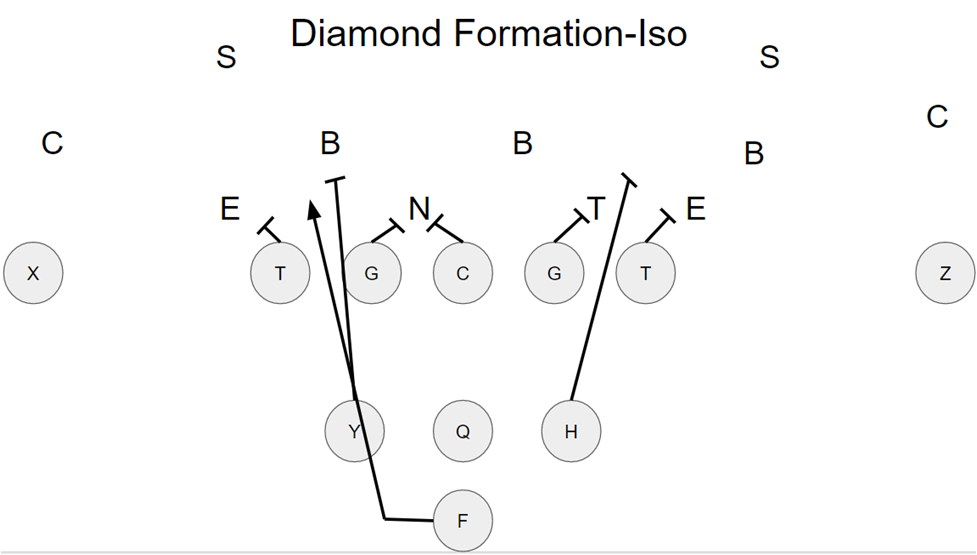The Diamond Formation is becoming a popular formation that forces the defense to put players inside the box to stop the run. This run heavy formation will force the defense to guard the receivers using man coverage. This creates a situation where your Quarterback can easily identify whether the defense is using more defenders to stop the run or the pass and exploit the numbers advantage.
Using the Diamond Formation to Create Mismatches
The formation is a twist on the basic T Formation that has been a popular Goal Line formation for decades. In the Diamond Formation the Quarterback will be lined up 4 yards from the Center in Shotgun formation. Immediately next to him, lined up behind the Guards, are the two blocking backs. These are your traditional Fullbacks who are strong physical runners but are more suited to blocking and opening up holes for the runner. Behind the Quarterback is the primary Running Back. Ideally this is a downhill physical runner who is capable of driving through any single tacklers.
The two receivers in the formation will be split out wide and on the line. The alignment of the receivers is critical to the success of the formation. These receivers need to be aligned as wide as possible. If the ball is on the opposite hash, they should be aligned on the outside of the numbers and if the ball is on their has they need to be one to two yards inside of the sideline. These huge splits force the defenders to make a choice on if they will commit to defending the run, or get out wide to help in pass coverage. If the defender stays in the middle he shouldn’t be able to defend the run or pass effectively.
From a running perspective you can run your base running plays but the formation is specifically designed to run the Iso Play.
Iso is designed to be a downhill play where the two lead backs are opening the hole up for the Running Back. The key with the play is to have the linemen take huge splits. Ideally they want to be aligned with 3.5 yard splits. This forces the defenders to pick a gap and makes it very clear for the backfield where the ball needs to be run. The Quarterback wants to check the run to the side with the best chance for success. Many times this will be based on the open B gap but other times it can be based on running away from one of the defense’s best players. Once he has declared the side the play is running to the roles are pretty simple.
The play-side lead back will lead through the hole looking to block the first man who appears in the hole. The backside lead back will ensure that no defensive linemen run through the inside gaps to make a tackle on the Running Back in the backfield. When he arrives at the hole he will read the block of the play-side lead back and go through the hole to clean up any extra defender that might appear. The Running Back is simply taking a shuffle step to the play-side before attacking down hill and find daylight to the outside.
Playbook PDF: Diamond Formation PDF
While the running portion of the Diamond formation can be effective the true strength of the formation is what it opens up in the passing game. With the nature of the formation the defense must put more defenders in the box to stop the run. This leaves the defenders one on one on your receivers. This makes for a simple check system for the Quarterback. As he comes to the line he always has the option to check to a pass without telling the line. All he is looking for is leverage to complete a simple route to the receiver. He has the option to check to a hitch, slant or fade. By running these concepts against a single defender the wide receiver is only a broken tackle away from a touchdown.
The Diamond formation is a physical formation. Your players will grow to love how they are able to physically punish the defense and move the ball down the field and the explosive plays that it can lead to in the passing game.
